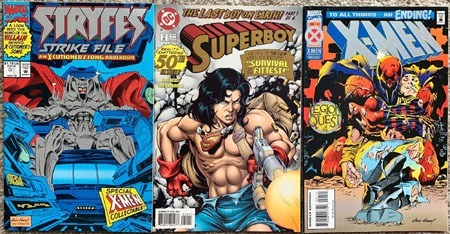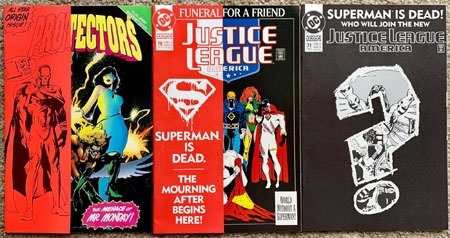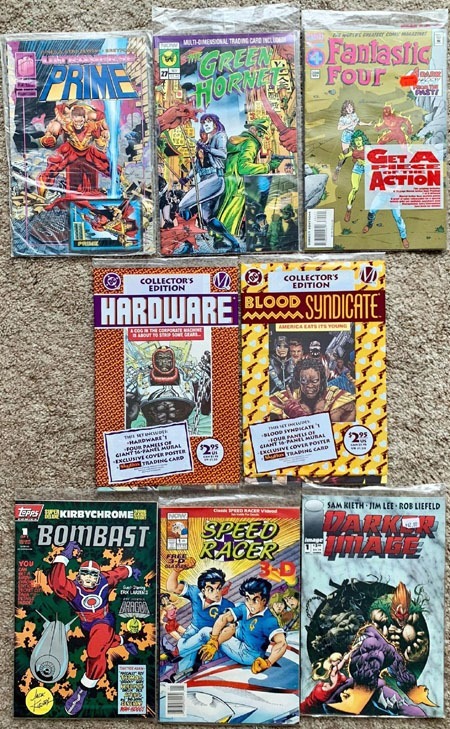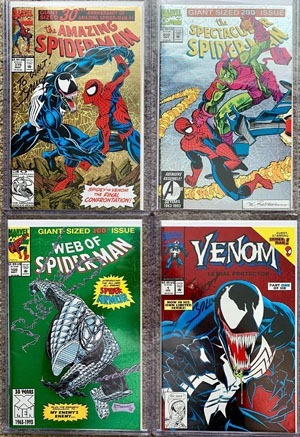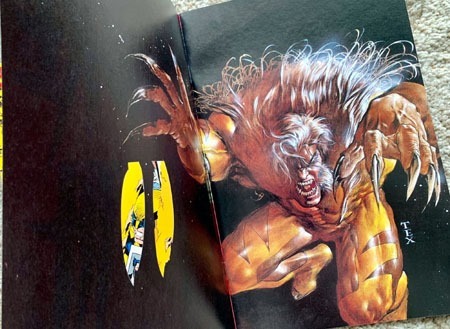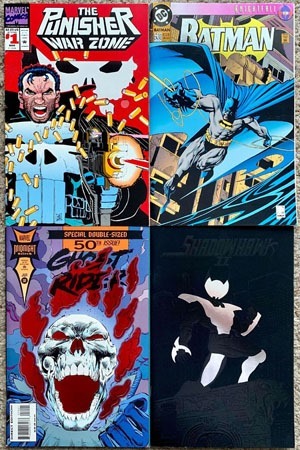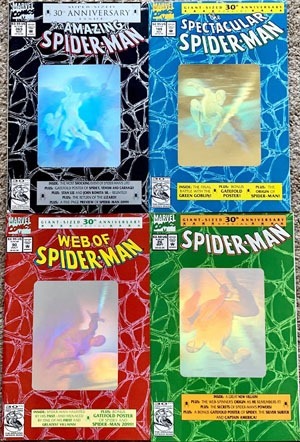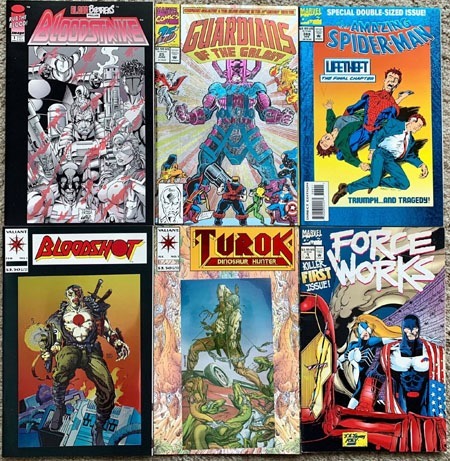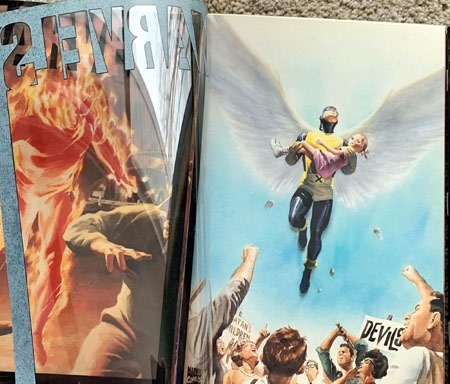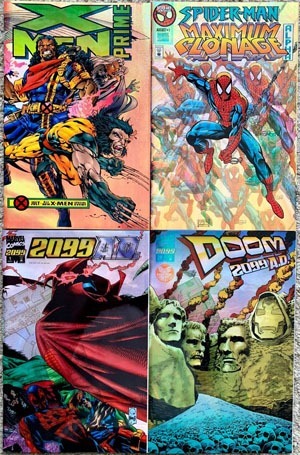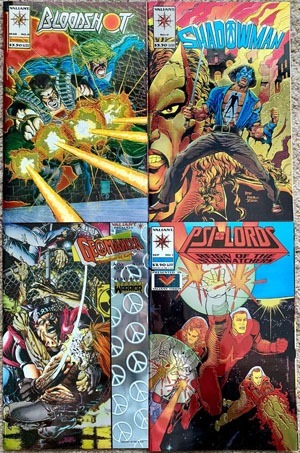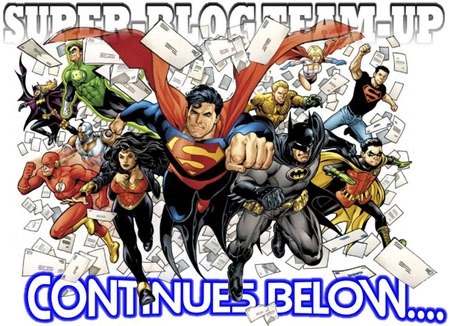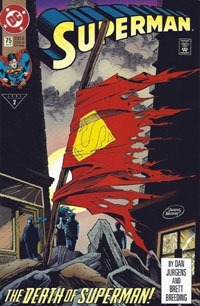Welcome to Wednesday…and another Super-Blog Team-Up! Where a number of comics blogs and podcasts come together at a shared time and a shared topic. We have that shared topic…but everyone picks a specific topic that fits within that group topic, and makes it their own!
I was invited into this group several years ago, and it’s been a great group to be part of–not only for the specific SBTU posts and episodes, but simply the great community the group has.
This time out, we’re looking at the topic of Chromium: The Era of Excess. That is, the gimmicks and such most seen in the ’90s and onward following the Golden, Silver, and Bronze Ages of comics.
My contribution is below…and at the bottom of this post (feel free to just skip to that!) is a list of the other participants and their posts this time around!
Prologue
I’d had some grand plans for this post. Even a large, detailed outline. Laying out some thoughts and my definitions of the Chromium Age, the Era of Excess; ways that Excess could be seen, and so on. A broad overview of gimmicks–from publicity/attention stunts to cover gimmicks to other stuff; as well as compare/contrasting ’90s gimmicks with modern variants. Perhaps I’ll eventually get to more of that, but it’s not happening this time.
From the moment of seeing the topic, I wanted to look at many of the comics that embodied this era of excess…namely, the shiny, flashy, attention-grabbing physical gimmicks of ’90s comics.
And of course, while I recognize much of the distaste that can be had for such things…I have–particularly over the last 10+ years–come to really enjoy these flashy, gimmicky comics of the ’90s. I relish purchasing them primarily from bargain-bins…these $3 and $4 and $5+ cover price comics that had these prices over 20 years ago–that I can get for that same price if not merely one shiny 25-cent-piece. And especially over this last decade or so, I’ve amassed quite a collection of such comics, their shiny-ness often jumping out at me from bargain bins, and especially the 25-cent bins.
This is by NO MEANS an EXHAUSTIVE list. There are many issues not even slightly touched on here: both known to me…and probably more unknown than I even show below. Particularly glaring to me as I write this is the Robin III mini-series with its polybagged lenticular covers–I have multiple copies of the issues somewhere but could not find them in a timely fashion to include in this post. Ditto the X-Men: Fatal Attractions issues–though I have an old image from scanning the covers myself and combining them with photos of the holograms such that I’m happy to use that in context here.
The following are presented in little order. While I begin with showing some tamer, more basic “enhancements” to covers, the various enhancements were developed over time and used at various times over the years by a number of different publishers. I’ve clustered them in some broader categories, though there’s surely plenty of room for argument and hair-splitting such that I only claim these as my own terms–particularly in context of this specific post–though you’ll definitely find other descriptions, definitions, and terms for certain enhancements elsewhere.
I also use a fair bit of slang that I’m sure I take for granted, but may not actually be defined or the clearest in general. If in doubt, feel free to post a question asking for clarification!
Despite the many examples I have to show–that I gathered up physically in-person to photograph–there are many, Many, MANY issues that fit in all of these categories that I simply did not collate in time for this piece, could not find in time for this piece, do not myself own, OR do not know about.
“Gatefold” covers are also not included here, though to me, the most prominent example of one of those is probably 1991’s X-Men #1, in its (in)famous “deluxe edition.”
But for now, instead of focusing on what is not or will not be covered (pun intended) here…let’s get into a brief overview of “shiny covers” as found on comics in the 1990s!
Extra Colors
Especially in the early days of comics, printing in color wasn’t an extremely advanced thing, I don’t think–not being an expert on printing presses and such, especially in terms of books/magazines/comics. There’s the notion of the “four color process” that I recall, wherein there was a limited color range made up of four basic colors.
So for comics to–even on the covers–have an extra color not usually seen in general, it would be fairly attention-grabbing.
Pulling a simple 3-issue sample, there’s Stryfe’s Strike File, Superboy #50, and X-Men #41.
These have an “extra color” with silver or gold ink prominently in the logos, making them stand out from the “usual” issues…and this photo doesn’t really do them justice compared to seeing the effect in-person.
I see this as a sort of “basic” “low level” “gimmick” where other than the visual color, the rest of the comic is pretty much as any other issue.
Paper Overlays
Another simple gimmick/”enhancement” for comics was having this extra piece on top of the covers themselves. It wasn’t exactly the cover, but it enhances the thing overall.
The Protectors one sets the thing apart with the brightly-colored paper to help draw attention to the issue, standing in contrast to the usual colors one would expect on a comic’s cover. The Justice League America #70 has a bright red overlay proclaiming Superman is dead. The mourning after begins here!
It–like the Protectors issue–allows this extra information/promotion copy without taking away from the actual image of the cover itself, which is full and intact beneath and very much a standalone image!
And the full-cover overlay on the 71st issue allows for one to NOT be “spoiled” merely by seeing the image at the shop…though one would probably be spoiled when going to read the issue itself.
But it seems a relatively simple and cheap thing to have this extra exterior “insert” (I know that’s NOT the word I’m looking for) as part of the publishing process while “enhancing” the otherwise normal/usual covers.
Batman #497–the issue where Bane breaks Batman’s back–also had one of the half-cover overlays proclaiming You thought it could never happen…the breaking of the Batman. Unfortunately, that’s another issue I couldn’t locate in my accumulation in time for this piece. Though I did do a ’90s Revisited post on the issue some time back.
Similar to this, I recall a couple of Spider-Man comics in the later-’90s that had two different covers attached–with some of the copies having one cover on “top” and the rest having the other. Essentially “variant covers” but BOTH covers came with every copy of every issue…a neat thing that I intend to cover some other time.
Polybagged Comics
There’s actually quite a bit of variety here, though I’ve got these issues grouped together. My emphasis here is the polybagging of the issues–that is, they come sealed in a plastic bag/covering, and in order to actually access their content–reading the issue, seeing interior art, getting at any trading card, poster, or whatever other goodies are included–means you have to cut open the bag and make the comic “worthless!”
I say that last part tongue-in-cheek because I remember even as a kid feeling it was rather ridiculous. I used to joke with a friend that someone ought to just put a cover onto a bunch of blank pages, polybag it, and put it out to see if anyone would notice. Or include some coupon to get the “real” thing if you actually DID open it!
To me, the general point of polybags was that these comics came with a trading card or such, hence the bag–the bag was not the comic, it was just a way to include extras without them having to be bound into the comics themselves.
The Mighty Magnor #1 can be opened out like one of those pop-up children’s books where moving stuff around results in a multi-level display that folds back up into the typical comic size. The bag would seem to protect it prior to one opening it up into its unique oversized glory.
The Captain Glory, Legionnaires, and X-Force issues come with a trading card. The X-Force #1 is especially egregious, even by contemporary 2020 standards: it’s the exact same comic, the exact same cover, the exact same bag…but there are 5 DIFFERENT trading cards. One would have to buy 5 copies of the issue minimum to get them all and ostensibly a sixth if they felt even slitting the bag to remove the issue to read meant they’d destroyed the issue.
Ren & Stimpy #1 is bagged both for a “scratch-and-stink” thing I believe, and you can juuuust make out under the bag that the reader will be scolded for destroying the comic now that it’s out of the bag.
And the Incredible Hulk issue is a Marvel Milestones reprint with some goodies included (and I only recently acquired it myself so have yet to open it up to get at the stuff).
Here are some more comics with mainly trading cards included, though Hardware and Blood Syndicate also include poster pieces that can be combined with the other two premiere Milestone #1s (Static and Icon) to form a huge 16-panel image. The Fantastic Four issue includes an animation “cel” from the animated series…a neat little promo.
If you grew up in the ’90s and think back…you may realize that NOT included here are two key Superman issues: the infamous Superman #75 black-bagged “death issue,” and Adventures of Superman #500 and its white-bagged edition. Those are topics for elsewhere and elsewhen!
Glow-in-the-Dark Covers
Glow-in-the-dark covers are relatively self-explanatory. These have an extra element bonded to the cover that–when exposed to light for a bit of time will then give off a glow when the surrounding environment goes appropriately dark. Of course, this likely means holding them up to a light, and then flipping the light switch to “off” and enjoying the effect for a few moments.
I believe this Ghost Rider issue was one of the earliest “gimmick covers”–at the least, I have a bit of deja-vu on having read something about that. The price of the issue was relatively unaffected despite the bonus effect…though that definitely cannot be said for MOST “gimmick” or “enhanced” covers! I’ve yet to actually read this issue or the Spectre issue. Green Lantern #50 and Superman #123 show the characters’ new costumes…
And here’s a shot of the issues taken in the dark/no flash. This copy of the Green Lantern issue is rather beat up and not my original…and is obviously a bit worse for wear.
Foil Stamped Covers
I’m considering “foil stamping” its own thing in that it’s a bit of foiling “stamped” on the cover, typically isolated to the comic’s title logo and used rather sparingly. In good light at the right angles, it gives off a nice, reflective look–as foil does–but the bulk of the cover is still “normal” colors.
There are many MANY of these comics out there, ’90s to present. I had these four handy (and the rest of the Rogue mini but figured one issue serves the point, and an issue of Shadowhawk I’d mis-sorted and hadn’t realized til these 4 issues were re-buried as I took photos for this post). A bunch of Ultraverse #1s have such editions where the only difference between them and the regular edition is a foil stamping on the logo.
Foil Covers
These covers go beyond the limited foil “stamping” to have the foil either making up the bulk of the cover or the entire cover.
Some of these have foil as a background “color” while others use it for good effect to accentuate stuff…while some just…are.
Photos don’t really do these covers much justice as the effect is much more noticeable “live” in-person when you see it.
Prismatic Foil Covers
These are much like the “plain foil,” but have more of a prismatic or patterned effect to the way they reflect light back at the viewer.
The Green Arrow #100 is technically more of a prismatic foil stamping but got sorted here, so here it is. Along with this #100 issue, similar “trade dress” with the prismatic foil “stamping” can be found on Superman #100, Flash #100, and Wonder Woman #100, also out around the same time, and not pictured here.
Closer up of the shiny effect on the Venom issue…
and on the Fantastic Four issue.
These three 30th anniversary Spider-Man issues plus Venom #1 have long been a “set” to me. I got all four when they first came out, and they’ve been a set in that regard at least since then for me.
They all have the same “webbing” pattern visible in the foil.
Here’s a closer-up on the Amazing Spider-Man issue (this copy I got signed by Mark Bagley last year!). Marvel got away with this 4-issue anniversary extravaganza as a 30th-anniversary despite the hologram series as these were the anniversary of Amazing Spider-Man #1 rather than just the first appearance of the character. Plus, they were big round numbers #375, #200, #100…and in Venom‘s case, #1.
The main 2099 #1s are another sub-set with a particular pattern within the foiling making up probably my favorite trade-dress for a series of titles. Though Ghost Rider was somewhat spoiled by being a much shinier/reflective foil.
Embossed Covers
Embossed covers are also straight-forward. They’re typically thicker/cardstock paper with embossing. That is, there’s a bit of a raised surface or texture, whether applied to the entire cover or just a logo or such. Think those old crayon-rubbings on paper where you put a sheet of blank paper over something, rub the crayon (or pencil) or whatever and see an image come through.
Here are several full-color embossed covers, and then two printings of a Fantastic Four single-color embossed cover. The former have the embossed logos, while the latter have the entire cover embossed. Catwoman is embossed throughout.
The Fantastic Four covers are both the same issue and same “image”…but two different printings. Different color for different printing, allowing one to have the same embossing, same image, but see at a glance that it’s a different printing.
Foil-Embossed Covers
For these, you have the embossing, but that’s combined with foiling. The points of embossing are foil, or is within a field of foil.
These are a mix of depth and degree of foiling/embossing and shiny-ness; from logos-only to the rest of the cover.
The Magneto #0 issue doubles as a mail-away comic if I recall correctly–another thing of the ’90s but not a focus of this post.
Still more with foil and embossing. The Avengers title had 4 of these covers in the year they were put out, if I’m recalling correctly; basically quarterly, so you’d have an extra-expensive issue with the “bonus” of the fancy foil-embossed cover followed by 2 “regular” covers, then another foil-embossed and so on. The Action Comics issue is in today’s terms a “variant,” as there were “Collector’s Edition” and “Newsstand Edition” covers; a topic for another time.
Here’s a closer-up of the Avengers cover.
Die-Cut Covers
Die-cut covers have very specific parts cut out–using a die–typically with another image underneath. I suppose these could be considered die-cut overlays, but in the sense of most of what I’ve seen, they tend to be more so a cover revealing a hint of something beneath, which might be more of a first page.
In the case of these issues–Wolverine #50, Sabretooth #1, and three of the four Reign of the Supermen launch issues–the cover IS the top, and they reveal part of an image underneath.
…such as the Man of Steel issue. It works as a cover showing off Steel’s version of the “S” shield…but when you open the cover you see a full-panel/page image of Steel…but no cover dress, as it’s not the cover itself (but works WITH the cover).
While Sabretooth‘s cover allows a hint of something beneath, and opens on quite the beautiful image of the feral villain.
I believe this came out about the same time as the first Deadpool #1, also a villain mini-series, though that one was simply embossed, if I recall correctly. (It is not pictured in this post)
Die-Cut Foil/Die-Cut Embossed Covers
Perhaps getting more to the sense of excess, we move here into the die-cut effect used in conjunction with embossing and/or foil to make up a cover.
The Punisher War Zone cover has embossing along with the die-cut, though one might not even know it just looking at the cover…it’s a subtle touch. The Ghost Rider and Shadowhawk covers have a foil sheet under the die-cut rather than foil stamping.
Batman #500 is a multiple-part mashup of “enhancements.” The die-cut for the top layer of the cover, foil cover underneath with embossing for the logo…and it’s a sort of overlay that on opening “reveals” the true cover underneath. PLUS it’s an extra-sized, extra-priced anniversary issue.
Hologram Covers
Hologram covers were covers featuring a “hologram” image. These varied in quality and size, and were presented in a number of ways. Primarily, they were approximately trading-card-sized images affixed to the cover; but some were larger, some smaller, and in the case of Malibu, the entire cover for several Ultraverse #1 issues!
Robin II featured one of the earlier egregious use of variants that I’m aware of. Not only was there a hologram on the covers, you had different cover images…but all with the same hologram per issue! However, the quantity of covers declined with each issue. #1 had 4 hologram covers, #2 had 3, #3 had 2, and #4 just had 1. (And all 4 issues also had a newsstand edition/variant with no hologram!)
There was actually a slip-cased box set for the Robin II mini that I’d picked up that came with one of each cover in a fancy box…definitely a novelty piece in my entire collection!
The box set also included actual trading cards of each hologram image as stand-alone things…pretty neat inclusion!
For the 30th anniversary of Spider-Man’s first appearance, there were these larger hologram images on respective issues of Amazing Spider-Man, Spectacular Spider-Man, Web of Spider-Man, and (adjectiveless) Spider-Man. These were possibly my earliest real introduction to such covers, as a friend had at least a couple of these (if not all four) prior to my even discovering other “enhanced” covers or even the black-bagged Superman #75.
Here are 6 “silver hologram” covers of Malibu‘s Ultraverse #1 issues. I believe there were also gold hologram editions–same image and effect, but with a gold instead of silver tint (though the latter three look slightly gold-ish due to the lighting and camera angle for this photo). Unpictured is an Ultraforce #1 that is gold…and I’ve yet to acquire Prime #1 in either silver or gold (though I’d prefer gold to go with these rather than trying to hunt 7 gold to have 8 match). Mantra and Prototype are basically hologram images of the regular edition covers while the others differ from the non-hologram covers.
Probably my favorite hologram covers were those used for the X-Men 30th-anniversary crossover event/story Fatal Attractions. Prior to these, other hologram covers seemed to be layered images with depth…while these felt like you were looking through a portal into an actual truly 3-dimensional object (namely a statue of the character).
I’ve recycled the above image from my ’90s Revisited series covering the event; I’d scanned the covers and taken photos of the holograms that I then pasted over the actual photo of the covers to show the depth of the holograms.
Here are several varied hologram images on covers. I suppose the Resurrection Man one might be more of a lenticular thing but looked like a damaged hologram when I first grouped these.
This Web of Spider-Man #125 is one of at least two of these holo-disc covers…the other being Spectacular Spider-Man #225. If you lay the book flat and shine a bright light on it, you can essentially look down into a circular well of a view and see Spidey sorta move as you turn the cover. Think the Pensieve from Harry Potter except you don’t fall into it.
The Silver Surfer #100 isn’t a particularly impressive hologram image…but it sure is pretty and shiny!
Other Covers
These are some covers that don’t exactly have their own categories; I’ve clustered them together for being a bit outside of a singular category or being a “set” (see below).
The Bloodstrike #1 issue “Rub the Blood” doesn’t–in the case of the physical copy I have onhand–work. A quick Googling suggests the blood should disappear when rubbed, but didn’t always work…so I don’t feel bad for not trying hard to get something to happen. I’d half thought it’d change color or brighten, but c’est la vie. The Guardians of the Galaxy issue with Galactus has a foil-like effect, perhaps a bit prismatic-ish, but something to its coloring and texture seems to be something else, hence separating it out.
The Amazing Spider-Man #388 has a textured foiling so isn’t really a straight up foil but isn’t what I tend to think of as embossed, though I suppose it might technically be embossed. The physical texture is a bit too “fine” for what I’d consider embossing.
Bloodshot #1 and Turok, Dinosaur Hunter #1 are some sort of foil/chromium thing with the fancy part affixed to the cardstock covers themselves. I recall Bloodshot being “the” buzz-issue the day my mom took a friend and me to get Superman #75 at Comics and Collectibles in November 1992. And over the years I’ve learned that Turok was apparently a bit of a bomb. But that’ another than that’s a topic for some other post in itself!
Finally, Force Works is another issue with a pop-up/pop-out cover.
While still not really doing it justice, here’s a closer-up look at the Guardians issue…
And the Amazing Spider-Man issue.
While looking at this title and in this “other” section…I should mention the embossed/die-cut/overlay of #400, which is another that I couldn’t find/dig out in time for this post, though I have at least one copy of it that I got at time of release. (It and #360 with the hologram apparently are much more expensive books these days than I ever realized!)
Acetate Covers
I haven’t seen many of these covers from the ’90s, though DC recently did a whole month of acetate covers. That being 2019, though, puts ’em 20 years outside the ’90s that I’m looking at!
These were covers that have a transparent/partly-transparent sheet over another cover/image where the two collectively make up the cover.
Marvels is the series I think of for acetate covers…though obviously the Tales of the Marvels: Wonder Years used the cover format, as well as Ruins (not pictured) and several other special issues–a Tales to Astonish issue, Tales of Suspense, Inner Demons, and apparently a Tales of the Marvels: Blockbuster issue. (all not pictured, either).
Here’s a look at Marvels #2 with the acetate opened, showing the full cover beneath (and you can see much of the cover of #1 through the acetate part!
While the Marvels and such covers used just the clear layer to put a logo over a “virgin art” cover…these got a lot more fancy and colorful with most of the image on the surface layer, and background coloring coming through from the secondary piece under it.
Chromium Covers
And here we get to the covers that inspired the naming of the age/era. Golden Age…Silver Age…Bronze Age…and what’s another metallic name? Chromium!
These covers were typically a thinner sheet of metallic/foil-like material and raised surfaces maybe akin to embossing, and you could often see a pattern of dots from the inside of the cover. I believe with the exception of Superman #82, all the chromium covers I’m aware of were wrap-around full-chromium. The Superman issue is a sort of cardstock with a front stub that the chromium sheet is attached to. It’s also the only DC comic I’m aware of in this format. Maybe they didn’t do it right and just didn’t do it again?
I should also note that somehow I never remembered–until deep into writing up this post–Ninjak #1 which may actually (once remembered) be one of my favorite chromium covers–and so do not have it in my specific mini-collection of chromium covers and thus it is not pictured here.
I’m pretty confident that X-O Manowar #0 was the first chromium cover I was aware of. As I’m recalling, it was actually my Dad who picked out my first copy–it caught his eye. It was followed shortly by Superman #82 collector’s edition. And then bookending the original Age of Apocalypse event/saga, X-Men: Alpha and X-Men: Omega sported these wraparound chromium covers.
Valiant got into these in a big way with the aforementioned X-O Manowar and Ninjak; also #0 issues for Bloodshot and Shadowman; and first issues for (at least) Geomancer and Psi-Lords.
Marvel also got into doing these covers in a big way. There were at least these 9 issues. I only recently–maybe in the last 5 weeks or so–became aware of this Sabretooth special issue (or at least this chromium cover edition if there was a non-fancy version). And it was only shortly before that I discovered the Fantastic Four 2099 #1 was a chromium cover; or that the Double Edge issue I had with the “death” of Nick Fury was a bookend issue and that the first part also had a chromium cover.
On the subject of Marvel and chromium covers…they apparently also did a series of Marvel Collector’s Edition reprint issues of various X-Men issues, and I think also Spider-Man; these being quite rare, and part of a handful of reasonable-ish “grail” issues for me (though having so many “cheap” chromium issues, it’s a double-edged sword for me. As with many other things…that’s a subject for another post!)
Over the years I’ve also come across several other chromium issues mostly in bargain bins, but a couple not.
And here’s a look at the Bloodshot and Shadowman #0s at more of an angle with light to show just how bright and shiny they are. Though as another refrain: they look even better in person!
The Era of Excess
I think I’ve spotlighted about 160 issues here, and mentioned still others.
Yet this doesn’t do more than put a big dent in showing off the shiny covers produced in the ’90s. While I find many of these covers “fun” now and love grabbing them outta bargain bins or on deep discounts…it was a different thing back in the ’90s. I fell victim to the mindset of “having to” get both the “collector’s edition” AND the “newsstand” edition of issues with the two. Superman #75 being the first such issue. Then others like the Adventures of Superman #500, the four launches of the titles into Reign of the Supermen.
I haven’t really looked at price in this post–that’s for some other time. As I recall, in general the “collector’s edition” covers were usually more expensive than the “newsstand” edition–sometimes twice or more so. And even with the “option” for the “cheaper” edition…with MANY of these, you had no choice. You either bought this double/triple/whatever-priced shiny/fancy thing…or you didn’t get that issue.
However…for the most part, the covers were still more or less singular. If you didn’t have a choice and had to pay more…it was still an iconic (or at least recognizable!) cover. I know Fantastic Four #375 at a glance just for the shiny sparklies. Or X-O Manowar #0. Any of the Fatal Attractions hologram covers. Or the 2099 #1s. X-Men: Alpha and Omega. Those Avengers foil-embossed covers for the 30th anniversary. Superman #75, the launches into Reign of the Supermen. And so on and so forth etc.
Others that had “collector’s edition” and “newsstand edition” (or non-“enhanced”) covers the two were often completely different images…some more recognizable than others. Superman #75 had a slate-gray tombstone look for the black-bagged edition; but it’s the newsstand edition–with the tattered cape fluttering on the wood pole–that is the iconic image. On the flip side, it’s the glow-in-the-dark version of Superman #123 that’s had a bunch of homage covers and seems (to me) to be “the” iconic image of that entire electric-blue era/costume for the character.
And the simple fact that I was able to pull together SO VERY MANY of these covers to photograph and share for this post shows (in small part) just how plentiful these were in the ’90s. That being said…I see them all as quite different from the modern “variant” covers. PARTICULARLY in quantity.
I don’t think I have EVER–comic store, dealer at a convention, whatever–seen boxes and boxes of “collector’s shiny edition” covers for sale. Maybe there are a bunch in bargain bins, but I’ve never seen them gathered together with an exclusive category/call-out…while I HAVE numerous times seen boxes and boxes of comics labeled “variants–$X price.”
Granted, you had all those Robin II variant regular-art covers with the same hologram affixed, plus the newsstand editions with no holograms. You had X-Force #1 where you had to buy 5 copies to get all 5 cards. Or X-Men #1 where you could buy 4 different covers that made up a single image…OR the “deluxe” edition gatefold cover with all 4 “panels” combined into the single image they were meant as…5 total covers to have ’em all. Or for its ongoing series, I believe Gen13 #1 had thirteen different covers. Slingers #1 had 4 different covers…and 4 different interiors!
But for the most part, IF you had “variants” in the ’90s…it was very much a 2-cover thing. Regular, and “enhanced.” OR–say, with several “platinum edition” covers or the Ultraverse limited foil and the full-cover holograms, for example–these particular “variants” were almost legendary and in no way “standard.” I got into the Ultraverse stuff in June 1993 when the line launched…but I think it was at least 2010 (17 years later!) before I ever saw one of the hologram issues in-person.
For at least the last 15 years with the ever-increasing quantity of variants, it seems that nearly every single issue of nearly every single series from nearly every publisher is put out with at minimum two different covers, and often 3 or more. I think recently I counted 30 different variants listed for an issue of Vengeance of Vampirella (from Dynamite, I think!). I’m pretty sure that there were more COVERS for that ONE ISSUE than there were pages of interior art! (And it was not even a first issue or any obviously-celebratory numbered issue!)
While I’ve yet to go through and do it, I’d be interested to see a list of comics being solicited in Previews in a single month of 2019 or 2020 that are NOT being published with variants. I’ve often wondered if it’d be easily-feasible to just collect comics withOUT variant covers.
Even where there were multiple shiny covers with one single series…the majority were never sequential…it was not every single issue nor every single series at once. (Granted, in the 2010s, DC has done several “gimmick months” where for that one month only, one issue per title only, there’s been some gimmick. Yet again, though….that’s another topic for another post).
Why I have such a problem with modern variants can be summed up with the following:
Just off the top of my head, on the Superman titles…(in terms of the ongoing series, not counting a number of quarterly giant-size specials in the late-’90s) you had collector’s & newsstand editions for:
- Superman #s 75, 78, 82, 100, 150, and 166
- Adventures of Superman #s 500, 501, and 505
- Action Comics #s 695
- Superman: The Man of Steel #s 22, 30, 50
That’s 13 issues out of…I don’t know, let’s say ~400 issues (Superman 75-175, Adventures of Superman 500-600, Action Comics 694-800, Superman: The Man of Steel 1-130-something, and Superman: The Man of Tomorrow 1-15)
Right now, 2020, just going back to mid-2016’s Rebirth renumbering for Superman…Let’s say May 2016-January 2020 (44 months) there’s been Superman #s 1-45 and 1-19 or so. Let’s call it 65 issues. But with DC doing two covers for every single issue…that’s 130 covers for 65 issues in 44 months. That’s not getting into Action Comics and the oodles of covers for #1000 on top of it’s 70ish issues. Nor taking into account adjacent titles like Supergirl, Superwoman, Super Sons, or Batman/Superman.
The ’90s get a bad rap for being an age of speculation and excess…but for me, the 2010s (2010-2019) drastically put the ’90s to shame in terms of covers.
I will absolutely grant that the ’90s very much can be considered the “Chromium Age,” though!
Don’t forget to check out the rest of this outing’s Super-Blog Team-Up posts! Find the group on Twitter at hashtags #SuperBlogTeamUp, #SBTU, and #SBTUChromium!
Super-Hero Satellite – 70s-80s Photo Covers
Chris is on Infinite Earths (Blog) – Adventures of Superman #500
Chris is on Infinite Earths (Podcast) – Episode 33: Team Titans #1 (1992)
Source material – Spider-Man Torment
ComicsComicsComics.blog – Daredevil 319-325 Fall from Grace
The Telltale Mind – Worlds Collide – The Intercompany Crossover
Between The Pages – Guerilla Marketing
Unspoken Issues – Darkhawk #25
Dave’s Comic Heroes Blog – Connected Covers gimmicks
When It Was Cool – Polybags It! The Blight of the Polybagged Comic Book
Pop Culture Retrorama – Glow in the Dark Covers
In My Not So Humble Opinion – It Came From the 1990s: Force Works #1
Black & White and Bronze Comics Blog – Spectacular Spider-Man Magazine 1968
DC In The 80s – Memorable DC “gimmicks
Comics In The Golden Age – Fawcett’s Mighty Midget comics
Filed under: 2020 Non-Review Posts, 2020 posts, NON-REVIEW CONTENT, Super-Blog Team-Up | Tagged: 1990s, Chromium, chromium covers, Collector's Edition, Collectors, comic books, comics, enhanced covers, foil covers, Newsstand Edition, Super-Blog Team-Up, variant covers, variants | 9 Comments »




